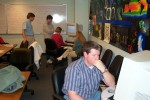The Schoolyard LTER program is getting a boost of support from some dedicated individuals. As a result of workshops and meetings that occurred at the LTER ASM 2000, a handful of LTER PIs, information managers, Education Liaisons and SLTER teachers formed a sub-group of the larger Education Committee. Using a post-ASM grant, a workshop was held at the San Diego Supercomputer Center December 2000. Participants included
- Karen Baker (Information Manager, PAL)
- Alan Berkowitz (PI, BES)
- Stephanie Bestelmeyer (Education Liaison, JRN)
- Rich Boone (PI, BNZ)
- Betty Connor (Teacher, BNZ)
- Monica Elser (Education Liaison, CAP)
- Marty Green (Teacher, KBS)
- Marianne Krasny (HFR)
- Patty Sprott (NET)
- John Vande Castle (NET)
The group interacted with representatives from the San Diego Supercomputer Center, including Kris Stewart of the San Diego State University Education Center on Computational Science & Engineering. Presentations from Reagan Moore and Ilya Zaslavsky of the SDSC, NPACI Intensive Computing group and from Ann Redelfs, Rozeanne Steckler, and Anna O'Neil from SDSC and NPACI education groups inspired a lively exchange of ideas, experiences and plans for future collaborations.
At the meeting, the SLTER group reviewed the past three years of the SLTER program, and formulated a set of goals, which will provide guidance to the SLTER program and promote opportunities for the K-12 Schoolyard LTER community to:
- Experience the nature of science with an emphasis on long-term ecological research
- Describe the local environment through observation, data collection, analysis and synthesis
- Connect with scientists to observe the research process, use of technology and communication of results
- Acquire an understanding of ecosystem diversity through linkages with the network of LTER sites
- Promote inquiry-based learning
- Explore the greater social context of science
Other activities of the SLTER working group include developing a Web site, a poster, a proposal, and a survey of SLTER activities. The SLTER group has also provided recommendations for content and development of the Schoolyard LTER Website (http://schoolyard.lternet.edu/), which will be produced at the Network Office.
A poster summarizing the activities and methods of many of the Schoolyard LTER programs at various sites was presented at the NPACI 'All Hands Meeting' at the SDSC in February 2001. The poster will be further developed and presented at the ESA meeting this August in Madison, Wisconsin.
Marianne Krasny is leading discussions about a joint proposal to the National Science Foundation with the National Science Teachers Association (NSTA). Marianne met recently with Shirley Ireton of the NSTA, George DeBoer (Teacher Enhancement at NSF), and Henry Gholz (DEB/LTER) to discuss ideas for a pre-proposal. Preliminary plans include developing supplements for science texts incorporating results of LTER research, data manipulation exercises and schoolyard research activities utilizing LTER research, as well as a system for dissemination of these materials through NSTA conferences, and on the NSTA and the SLTER Web sites. The pre-proposal will be submitted in May 2001. If you would like to be involved, please contact Marianne Krasny.
SLTER teachers frequently say that long-term, broad-scale data is what makes the LTER program unique among myriad biology education programs they are faced with every year. Access to this data in a useful form is integral to the success of the SLTER program, which seeks to integrate LTER principals with K-12 education. Perhaps the most important recommendation the SLTER group developed at the December meeting involves coordinating with national metadata standards initiatives to facilitate cross-site SLTER interoperability. Continued recommendations regarding standards are among the priorities of the SLTER working group.
Preliminary Results of SLTER Survey
(9 Sites represented)
|
Supplement Date |
|||
| 1998 | 1999 | 2000 | |
| # of LTER PIs involved | 36 | 37 | 38 |
| # grad/undergrad assistants involved | 50 | 43 | 62 |
| # K-12 teachers involved | 134 | 169 | 230 |
| # K-12 Students involved | 1,987 | 3,156 | 3,490 |
Finally, a survey of SLTER involvement at LTER sites was circulated and results are in for the 13 of the 21 LTER sites that have had the supplements for three years (see box). The survey provides a preliminary snapshot of Schoolyard activities at LTER sites. Even with only a few sites represented here, the numbers are impressive.
"In our survey, we included students who participate in the field trip program, the classroom visit program, and the students who have plots set up at their schools," says Stephanie Bestlemeyer, Education Coordinator at Jornada Basin LTER. "All kids get to interact with scientists and do experiments, so this is all part of the SLTER program here."
Stephanie says her survey figures represent the actual number of kids reached through the program, not including repeated visits, which are common. "For each class of 25 kids we work with on the plots outside schools, we may see them four or five times during the school year. [But] I just counted them as 25 kids." It is integral that more sites respond for a more complete picture of the impact of the SLTER program to develop.

 Enlarge this image
Enlarge this image